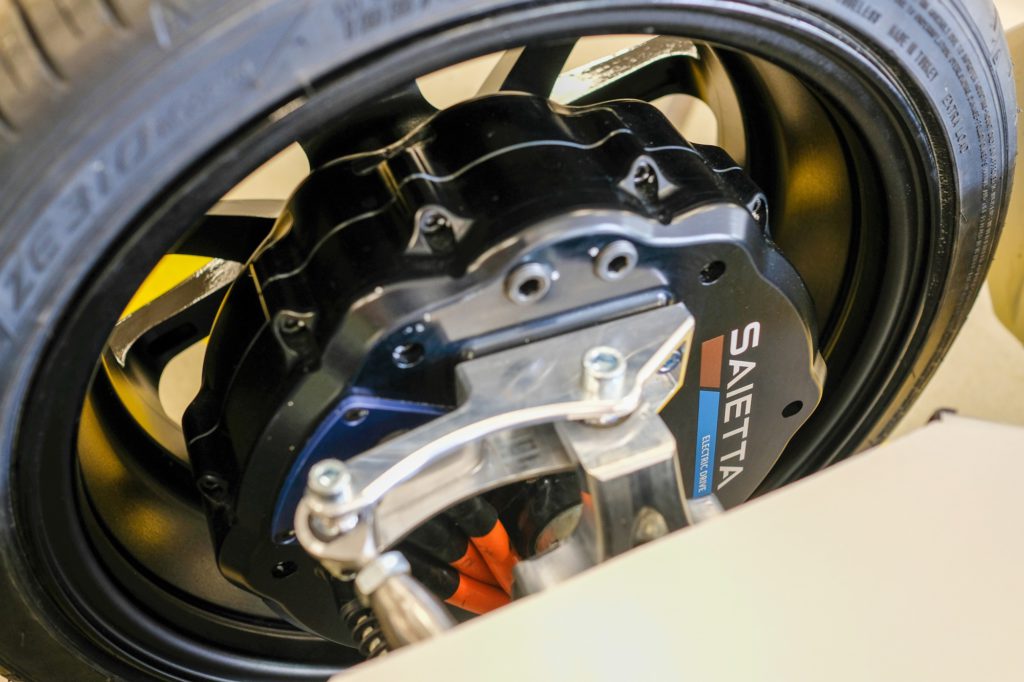Saietta showcases in-wheel motor technology
15 June 2021

Saietta has showcased its in-wheel, battery-electric vehicle (BEV) concept. The company’s Axial Flux Technology (AFT) 140 electric motors deliver high-torque density at low voltage, making them an ideal solution for urban mobility.
While carmakers have been revealing dedicated electric platforms designed to power entire families of BEVs, new technologies continue to hit the market. This offers up a choice; stick with what you know or experiment with new systems in the pursuit of better performance.
All in wheel
The Oxford-based engineering company has been able to move an entire BEV powertrain inside of the wheel, leaving a perfectly flat floor and more chassis space. The motors are engineered to deliver power and torque at low voltage, making them safer than high-voltage alternatives. Plus, the lightweight solution means a more compact setup, fewer parts and less build complexity. The developer also believes it is a more cost-efficient path to electrification because heavy, intricate and expensive components have been eliminated.
The in-wheel motors are designed to provide manoeuvrability, flexibility, modularity and four-wheel-drive capability. Regenerative braking also plays a core role, putting energy back in the battery. The 140 AFT motors have also been built to deliver high efficiency on urban journeys, meaning vehicles go further on a single charge.
‘Saietta is all about high-tech, real-world, application-ready electric-drive technology. We continue to strive to create electric-drive solutions for vehicle manufacturers around the world, and this in-wheel motor variant for smart mobility platforms is another example of our progress,’ said Wicher Kist, Saietta Group CEO.
‘We are not intending to become a platform manufacturer and only developed a chassis to demonstrate the power of our in-wheel motor innovation. We want to work with platform developers, complementing rather than competing with their innovation. Ultimately, we believe that inner-city electric vehicles will be fully autonomous and our in-wheel motor technology can play an important role in this market,’ Kist added.
The company believes a new generation of electric vehicles is needed for inner-city transportation, and electric smart-mobility platforms can be part of the solution. These foundational power-beds can be fitted with different ‘hats’ or tops, to become people carriers, last-mile delivery vehicles, mobile shops, waste-collection units or autonomous pods. ‘Now is the time to have a serious industry discussion about the potential of in-wheel electric motors in making congested city centres quieter and cleaner spaces,’ Kist concluded.
Flexible for all
In recent years, carmakers have unveiled new architectures built to drive whole families of BEVs. Volkswagen Group (VW) has its Modular Electric Drive (MEB), which underpins the all-electric ID. family and is to be used by other OEMs like Ford. Hyundai’s new Ioniq models will all sit on its Electric Global Modular Platform (E-GMP), enabling fast-charging capabilities and ‘plentiful’ driving ranges. Last August, Volvo Car Group announced it had sold over 600,000 vehicles based on the Compact Modular Architecture (CMA) platform since its introduction in 2017.
However, while universal platforms promise to simplify production for manufacturers, other developers like Saietta are highlighting the potential for greater modularity and customisation. In April, REE entered a collaboration with automotive supplier Magna to bring fully-modular electric vehicles to the market, fulfilling what it saw as the growing need of next-generation electrically-chargeable vehicle (EV) builders by accelerating their time-to-market at scale. Not unlike Saietta, REEcorner packs the steering, braking, suspension, powertrain and control components into the wheel arch, leaving OEMs with the ability to customise the rest of the vehicle.
BEV technology is developing at an increasingly rapid pace. What is ground-breaking one day can appear outdated the next. While VW, Hyundai and Volvo all offer customisable bases to work from, these platforms still feature drive motors at either one or both ends, shortening the potential battery and making the vehicle-body design more complex. In-wheel systems allow for a larger, more customisable setup, although this does look to be at the cost of more powerful motors. But, as carmakers and developers continue to build more advanced systems, platforms should be kept flexible to incorporate new breakthroughs and make the most of what is on offer.


